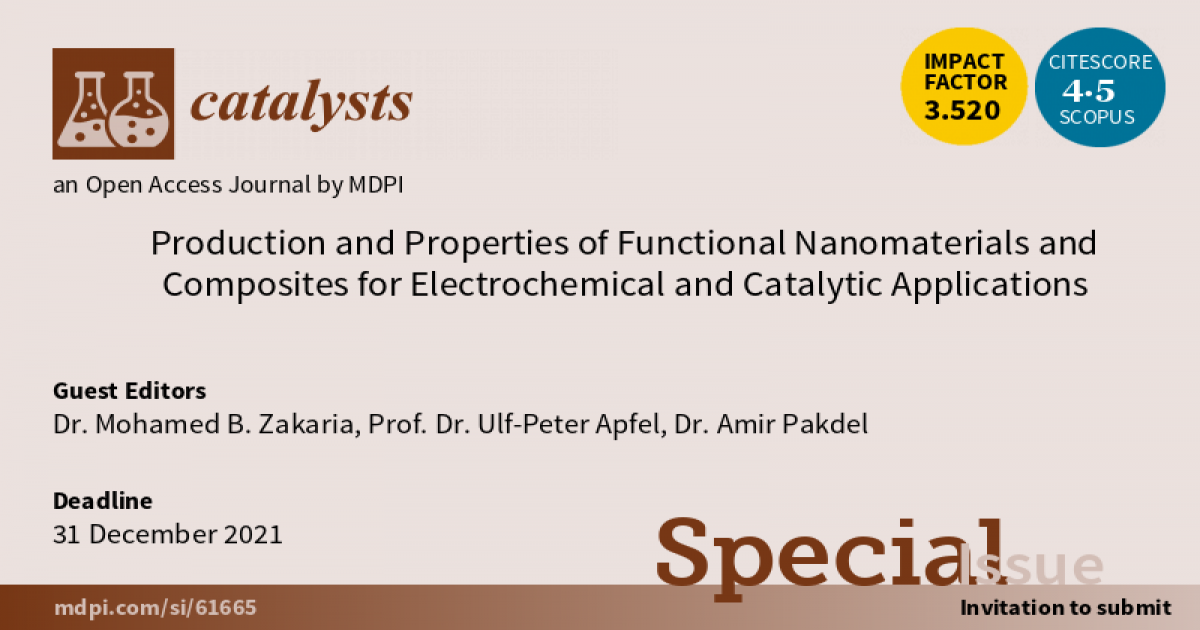Production and Properties of Functional Nanomaterials and Composites for Electrochemical and Catalytic Applications
A special issue of Catalysts (ISSN 2073-4344). This special issue belongs to the section "Electrocatalysis".
Deadline for manuscript submissions: closed (31 December 2021) | Viewed by 7082

Special Issue Editors
2. Fraunhofer UMSICHT, 46047 Oberhausen, Germany
3. Department of Chemistry, Faculty of Science, Tanta University, Tanta 31527, Egypt
Interests: MOFs and PCPs; functional applied nanomaterials; layer-by-layer (LbL) assembly; heterostructured electrode; composites; electrocatalysis
2. Fraunhofer UMSICHT, 46047 Oberhausen, Germany
Interests: renewable energy; electrocatalysis; bioinorganic chemistry
Interests: 1D/2D nanomaterials; composites; surfaces and interfaces; energy and environment; thermoelectrics; batteries
Special Issues, Collections and Topics in MDPI journals
Special Issue Information
Dear Colleagues,
Intensive research is being conducted into highly efficient and inexpensive nanoscale materials for electrochemical applications in renewable and clean energy systems. Nanostructuring of hybrid materials with multiple functions that are not attainable with their single components is a promising way to provide efficient and cheap electrocatalysts with comparable performances to noble metal-based catalysts and rare metal oxides. To develop hybrid functional materials into various types of electrodes with highly active layered morphologies, the assembly of functional two-dimensional (2D) materials is widely investigated. Particularly, 2D coordination polymers (CPs), including porous coordination polymers (PCPs) and metal–organic frameworks (MOFs) into well-defined three-dimensional (3D) structures using graphene oxide (GO) and/or reduced graphene oxide (rGO) nanosheets, produce efficient hybrids. These well-designed structures are promising precursors for nanostructured metal chalcogenide and/or metal oxides/rGO/carbon composites through a solid-state thermal treatment process.
An effective approach to increase the electrochemically active surface area in contact with electrolytes is to incorporate an abundance of pores within the materials via annealing, which will also provide sufficient channels for electrolyte penetration. Moreover, heating in an inert atmosphere improves the graphitic carbon, which leads to a remarkable enhancement in the electronic conductivity of rGO. To further improve the electrochemical properties of these catalysts, doping with heteroatoms such as nitrogen (N), sulfur (S), phosphorous (P), and/or boron (B) has been performed. The difference in electronegativity between carbon and heteroatoms and the high electron charge density of heteroatoms improves redox efficiency.
We invite researchers to contribute original research papers as well as review articles on electrochemical applications of novel CP (PCP and MOF) nanomaterials, their hybrids with carbon materials, and their thermally derived functional materials and electrodes. Topics of interest include but are not limited to performance evaluation of nanostructured functional materials for water splitting, including oxygen evolution reactions (OERs) and hydrogen evolution reactions (HERs), oxygen reduction reactions (ORRs), CO2 reduction, supercapacitors, batteries, etc. comparable to the currently used materials.
Dr. Mohamed B. Zakaria
Prof. Dr. Ulf-Peter Apfel
Dr. Amir Pakdel
Guest Editors
Manuscript Submission Information
Manuscripts should be submitted online at www.mdpi.com by registering and logging in to this website. Once you are registered, click here to go to the submission form. Manuscripts can be submitted until the deadline. All submissions that pass pre-check are peer-reviewed. Accepted papers will be published continuously in the journal (as soon as accepted) and will be listed together on the special issue website. Research articles, review articles as well as short communications are invited. For planned papers, a title and short abstract (about 100 words) can be sent to the Editorial Office for announcement on this website.
Submitted manuscripts should not have been published previously, nor be under consideration for publication elsewhere (except conference proceedings papers). All manuscripts are thoroughly refereed through a single-blind peer-review process. A guide for authors and other relevant information for submission of manuscripts is available on the Instructions for Authors page. Catalysts is an international peer-reviewed open access monthly journal published by MDPI.
Please visit the Instructions for Authors page before submitting a manuscript. The Article Processing Charge (APC) for publication in this open access journal is 2700 CHF (Swiss Francs). Submitted papers should be well formatted and use good English. Authors may use MDPI's English editing service prior to publication or during author revisions.
Keywords
- Coordination polymers (CPs)
- Layered inorganic–organic hybrids
- Functional applied nanomaterials
- Nanoporous catalysts
- Metal chalcogenides, phosphides, and borides
- Metal oxides and carbides
- Heterostructured electrodes
- Electrochemistry
- Energy conversion and storage
Benefits of Publishing in a Special Issue
- Ease of navigation: Grouping papers by topic helps scholars navigate broad scope journals more efficiently.
- Greater discoverability: Special Issues support the reach and impact of scientific research. Articles in Special Issues are more discoverable and cited more frequently.
- Expansion of research network: Special Issues facilitate connections among authors, fostering scientific collaborations.
- External promotion: Articles in Special Issues are often promoted through the journal's social media, increasing their visibility.
- e-Book format: Special Issues with more than 10 articles can be published as dedicated e-books, ensuring wide and rapid dissemination.
Further information on MDPI's Special Issue polices can be found here.







